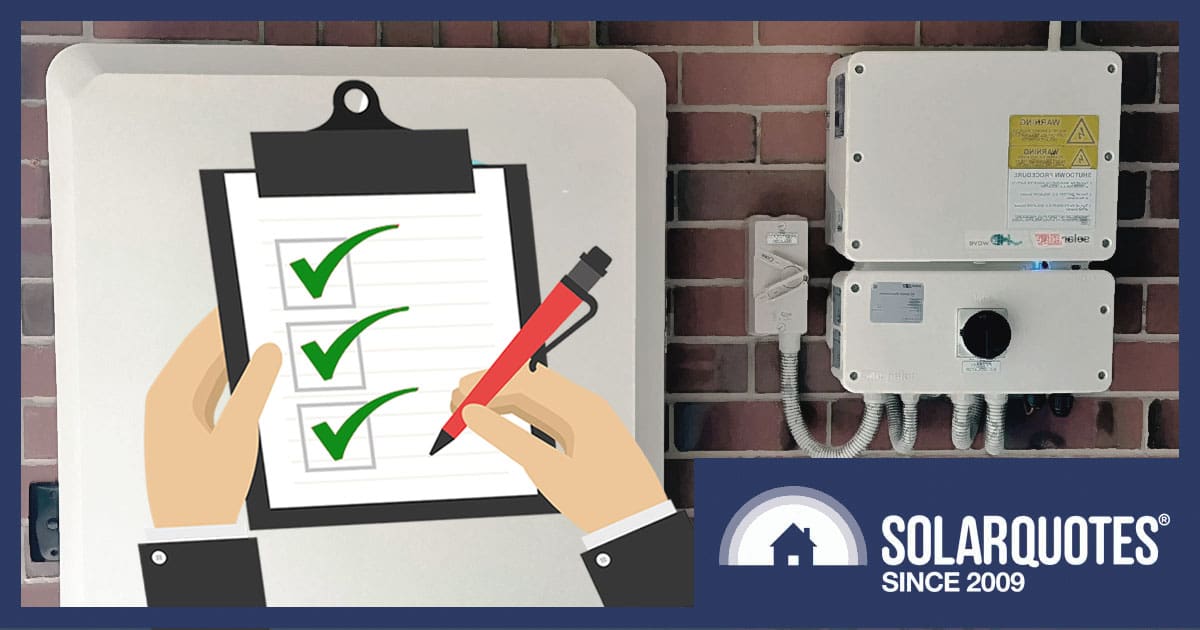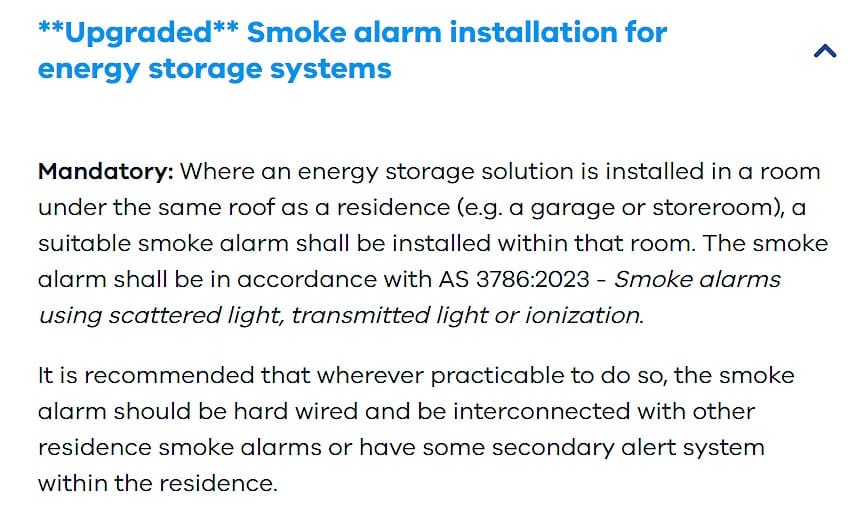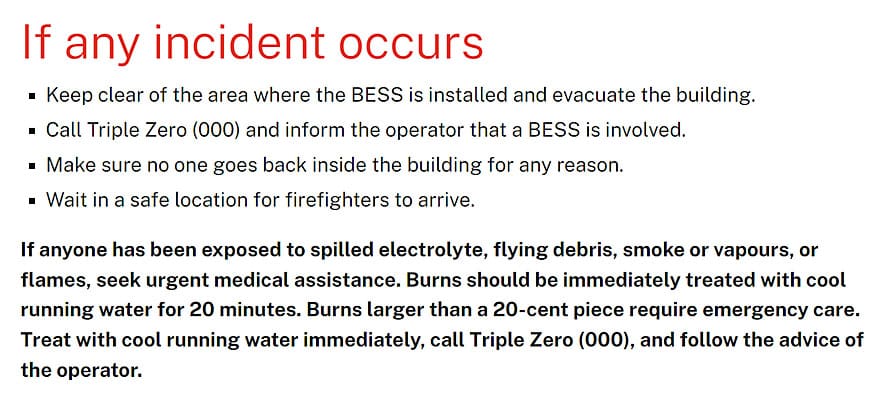
Many local councils actively promote the importance of having a bushfire survival plan to residents. Given the potential risks associated with home batteries, should homeowners also have a dedicated emergency response plan for their home battery systems?
It’s good to know that a suitably qualified installer will tick all the regulatory boxes associated with safe battery installation, but what happens when they leave your front door?
Did you know, for example, that the Australian Standard that installers must comply with (AS/NZS 5139:2019 – Electrical installations – Safety of battery systems for use with power conversion equipment) doesn’t require all battery systems to have a smoke alarm?
That seems odd, considering the high level of by-laws around smoke alarms in other parts of buildings that may not be as exposed to a potential fire risk. I can see you rolling your eyes, saying, “Not another bloody regulatory hoop to jump through.”
Do You Need A Smoke Alarm?
I’m not saying we need to make smoke alarms mandatory for all home batteries, but some states and territories have done just that in some instances, so maybe a change is in the wind.
In the ACT, Access Canberra’s ‘Smoke Detector Requirements for Battery Systems in Residential Applications’ state:
“A smoke detector is required where battery storage systems;
- Are in a garage under the same roof as the residence, or attached to the residence.
- In a storage space under the same roof as the residence.
A smoke detector can be omitted, where battery storage systems;
- Are externally mounted on an outside wall of the residence.
- Inside a shed or garage (class 10) that is separated from the residence (class 1.)
- In an open car port.”
Since July 2023, Solar Victoria has made it a requirement to be eligible for battery loans:
“Where an energy storage solution is installed in a room under the same roof as a residence (e.g. a garage or storeroom), a suitable smoke alarm shall be installed within that room. The smoke alarm shall be in accordance with AS 3786:2023 – Smoke alarms using scattered light, transmitted light or ionization.“

One of the many Solar Victoria requirements to be eligible for battery rebates.
In no other Australian state or territory is it currently mandatory to have a smoke alarm in the vicinity of all types of BESS1 (battery energy systems), although some fire authorities recommend it.
FRNSW (Fire & Rescue New South Wales) has some good advice on their website:
“FRNSW recommends that a smoke alarm or a heat alarm is installed in garages or utility rooms where a BESS is installed. We recommend having a licensed electrician install and interconnect mains-powered devices where possible. Check with the manufacturer or distributor to ensure device models are compatible for interconnection.”
So, enough about smoke alarms. On their own, they don’t constitute a fire safety plan. A smoke alarm isn’t even your first line of defence when preventing fires from a home battery.
Your First Line Of Defence
If smoke is pouring out of a battery, it means thermal runaway has started, and catastrophic failure is imminent. A fire will almost certainly follow. It would be handy if there was some other indicator before it happens, and thankfully, there is.
Monitoring App Is Your Best Friend
The BMS (Battery Management System) is designed to automatically shut down your battery when it exceeds predetermined operating temperatures. Ideally, when this happens, there should be a fault code on your app or web portal indicating the issue.
When/if the temperature recedes, the battery may automatically resume operation. Please follow the advice in your manual, and if it repeats, definitely don’t ignore it. It would be better still if you could pre-emptively set up an app notification for specific alarm codes. That way, you can catch minor problems before they become major.
Gas Detection Is Better Than A Smoke Alarm
As a battery cell begins to fail, electrolytes break down and generate gas before a thermal runaway event is likely to occur. Off-gas monitoring can buy time and provide up to thirty minutes earlier warning than smoke detection.
Hard-wired gas monitoring systems are common in industrial settings such as production facilities, but as of the time of writing, suitable detectors for lithium-ion batteries in a residential home are probably cost-prohibitive. Bummer.
How To Put Out A Home Battery Fire
Don’t!
This is what the Queensland Fire & Emergency Services has to say:
“If your li-ion rechargeable device is on fire, or smoke is coming from it:
- Call Triple Zero (000) immediately and report the incident.
- Don’t touch a damaged battery or device – severe burns could occur.
- Raise the alert and ensure everyone evacuates to a safe area.
- Don’t breathe the air around the battery or device – it will likely contain toxic vapours.”
Every fire authority in Australia has similar advice. FRNSW (Fire & Rescue New South Wales) states the following on their website:

Clear advice from FRNSW (Fire & Rescue New South Wales) about what to do if an incident occurs.
Is A Home Battery Safety Plan Necessary?
That’s totally your call. Perhaps you think it’s a bit over the top? If so, let’s just call it ‘doing your research’. I think you’d be a mug not to be prepared for an emergency situation if you own a home battery.
For the Boy Scouts among us, here’s what a basic Home Battery Safety Plan might look like. It would vary depending on your particular battery chemistry, battery location, and manufacturer’s recommendations:
Home Battery Safety Plan: Quick Guide
✅ Emergency Shutdown: Familiarize yourself with the emergency shutdown procedure – only to be used in a pre-thermal runaway state (no smoke or flames.)
✅ Maintenance And Inspections: Follow the manufacturer’s advice for regular maintenance and inspections.
✅ Fire Prevention: Keep the area around your battery clear of flammable materials. Consider installing a smoke alarm in the vicinity. Set up any relevant notifications on your monitoring app.
✅ Evacuation Plan: Develop and communicate a clear evacuation plan for your household, including all evacuation routes and meeting points.
✅ Emergency Contacts: Maintain a list of emergency contacts, including fire authorities and battery installer. Keep this list easily accessible.
✅ Stay Informed: Stay updated on safety guidelines provided by your battery system manufacturer. Be aware of any recalls and updates.
Having A Plan Means Peace Of Mind
While regulations might not mandate it, having a basic safety plan is just plain smart. From app alerts to knowing emergency procedures, a little prep ensures your power stays on and your worries stay off.
Footnotes
- Apart from this rule in AS NZS 5139:2019 regarding pre-assembled integrated BESS – “Where a pre-assembled battery system (or systems) are installed in a building with a fire indication panel, a detector linked to that fire indication panel should be installed in the room containing the pre-assembled battery system. For all other buildings a smoke alarm should be installed within the same room.” ↩

 RSS - Posts
RSS - Posts



As proof that a lot of firefighters spend a lot of time sitting in the station surfing nonsense on social media, a local firefighter when we got a Powerwall said ‘water will be no good for that, you’re going to need a dedicated lithium fire extinguisher, and those are extremely expensive’. Mistaking a lithium metal fire with a Li-ion fire, which (I believe) can be extinguished with water like many other fires.
Ours is on an outside wall, and on a very shaded southern side of the building, which was deliberate. It gives me more peace of mind.
We used to instal heat sensor in series with smoke alarm over all our computer server racks after a lead acid powered APC UPS melted its surroundings without setting off smoke alarm. Wonder if that might be extra safety measure with Lipo? Heat sensors are cheap!
Firefighters regularly report that Li-ion fires take far more water and time to extinguish, assuming they can at all.
A Swedish guy is claiming that a raging EV battery fire can be extinguished in 10-15 minutes with only 750 litres of water if the correct techniques and tools are used, but the techniques differ to those used in standard fires i.e. firefighters aren’t trained in them, and the tools are ones I suspect most firefighters, especially in Australia, don’t have access to.
Given the increasing instances of vehicle thermal runaway fires reported on youtube in John Cadogan’s blog I guess it is lucky that home battery systems do not seem to be so badly affected currently.
These fires are frightening as they produce their own oxygen and have to be left to burn out as fire brigade water is ineffective. I think smoke/gas alarms should be compulsory.
I would be reluctant to have a car charger / electric car or home battery system close to my house and try to avoid parking close to them in car parks, especially underground / multi story ones.
EVs catch fire in orders of magnitude lower numbers than ICE vehicles. Just another example of how social media generates and magnifies factually empty hysteria. Yes a thermal runaway fire is hard to put out, but it’s also much, much harder to ignite a battery than a fuel tank. And it’s by no means easy to deal with an ICE on fire. Talk to actual firefighting professionals and they’re not too concerned, they already have a whole range of different types of fires to have to treat differently. It’s no biggie for them, just new, so they need to bed down new procedures.
Really?
That’s absolutely rubbish, and you’re just spreading the hype.
Do just a little bit of PROPER homework on the number of electric vehicle fires vs ICE car fires.
Electric vehicle fires from all the reputable manufacturers are incredibly rare.
Of far more concern is dodgy Chinese batteries and equipment in things like (but NOT limited to) electric scooters, bikes, and skate boards.
This issue seems to me to be a beat up, but I am genuinely interested in the risks. Are there any statistics? Most people have all manner of flammable materials stored in garages. How much additional risk does a Li-ion battery add? It is not a rhetorical question. I think people have a sort of natural phobia toward “new” technology. How many houses have been lost due to fires caused by solar stage batteries, say, compared to portable electric radiant heaters? The latter seem to cause a majority of accidental house fires every winter. They are routinely sold, and more or less unregulated. Do I need a “portable electric heater safety plan”? Probably more than I need a “home battery safety plan”…
Hi Eddy. I do not know. I would love to see some statistics. Almost everyone with a garage has a car parked in it half-full of petrol. THAT is extremely flammable. I think if one was really worried about fire they would drive a diesel.
People think nothing of plugging in a radiant heater. I do not know the statistics, but that would be my benchmark for fire risk. How do electric vehicles compare to that? I drive diesels and I don’t use portable electric heaters. I do have a wood combustion heater. That is probably my single biggest fire risk factor. Well perhaps after potential faulty wiring. My house is over 50 years old…
As prevention is better than cure, my top plan item is: Install only LiFePO₄ batteries, as they don’t contain flammable organic electrolytes. I’ve only heard of one overheating, but it only emitted ugly grey smoke, best not inhaled, and left some wipe-off smudges on the wall. That was in USA. Any in Aus?
My delivery of 48 LiFePO₄ cells is half an hour away, the courier just phoned to say. QUESTION: Is it OK to build the three 15.5 kWh batteries in a hardwood framed cementsheet lined enclosure? Hardwood has to be a lower fire risk that volatile organic electrolytes, and the cement sheet can be on the inside. HRC fuses and good quality BMSs will take care of overcurrent, and overcharge/discharge, the other fire risks. Balancers handle the cell overvoltage/undervoltage risks.
For rapid disconnection I have a 3-fuse holder with a big handle. Pull it, and the fuses are yanked out. The 100A HRC fuses have a rupture capacity of 100,000 amps. (They’re physically massive.) So, in emergency, grab it and run is enough for the battery side. That leaves only the PV side to sort out as the install gets under way.
One of the 4 smoke alarms is in that workshop, and new builds in Victoria have to have hard wired alarms, so that’s good too.
Now I have to get the ute out for the quarter tonne of batteries, BMSs, and cell balancers about to lob up. I’ll put the jerry can with 20 L of petrol in the cab for the trip, just for the sake of staying alive. Will also have to take great care building the batteries, as flash burns can not only hospitalise, but permanently disable.
Small risk with large stored energies requires a bit of effort, and careful forethought, I figure. (Lest they are released.)
I am a fan of Lithium Titanate (LTO) batteries. To my knowledge they are never a fire risk.
My brother has had 8 Zenajis for a year or two now, and swears by LTO. His 19 kW array usually has them charged by 10 a.m. after a night running 3 fridges, 2 freezers, 2 aircons, after the evening’s cooking on the electric stove.
After 10 a.m. he’s often exporting 10 kW, so he’s sited in a juicy spot network wise. Nothing can charge/discharge at LTO’s phenomenal max rate, and nothing else matches the cycle life. (20,000) Mind you, nothing else matches their price, either.
With 3 times the capacity for half the price, in DIY LiFePO₄ cells, I can equal the power, and not regret the shorter cycle life. Admittedly, greater care in charging rate, charging voltage, and temperature is needed just to achieve 6000 cycles. My calculus is that not only will something niftier come along before they give up, but the 46 kWh capacity should in my case only reach 6000 cycles after 60 years, at two per week. The cells will be at end of calendar life in a third of that time, at best.
I think both LTO and LiFePO₄ are one or two orders of magnitude safer than Li-Ion, which I won’t allow in my house in anything bigger than a cordless drill. I keep them away from flammables, and charge them and my mobile only while I’m around. My cousin in Copenhagen has just bought a fireproof bag for her Li-Ion electric mower battery. I might build a steel Li-Ion charging safe, as shown on an ABC TV program, which showed young folk doing Wile E Coyote imitations when their one-time vapes spontaneously flared incandescently in their pockets. Progress is sometimes retrograde, I reckon.
I am lucky I was home the day I heard an unusual noise from my battery which is installed under the main roof in a garage. On inspection the battery was emitting smoke (not flames). I immediately turned off the battery switch installed very near to the battery. The battery stopped smoking. After a six week wait, the battery was replaced with a new one. Unfortunately the warranty date didn’t start afresh – it was backdated to the installation date of the defunct battery
When we had our BYD battery installed here in in our garage in our Victorian home, I had QLD level smoke detectors installed, including one in the garage.
What’s the difference? QLD standards state that if one detector goes off, all the detectors in your home go off, so no chance (if you’re home) of missing it. I test them twice a year. (There’s a panel with a switch to turn them all off at once – thankfully.)
I used to work in the oil refining industry, so am very respectful of fire hazards.
So, that’s my suggestion. We used https://redsmokealarms.com.au/product/240v-smoke-alarm-with-9v-battery-back-up/